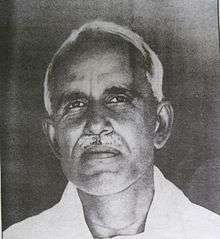- O. P. Ramaswamy Reddiyar
-
Omandur Ramaswamy Reddiyar Chief Minister of Madras Presidency In office
March 23, 1947 – April 6, 1949Prime Minister Jawaharlal Nehru Governor Archibald Edward Nye,
Krishna Kumarasingh BhavasinghPreceded by Tanguturi Prakasam Succeeded by P. S. Kumaraswamy Raja Personal details Born
Omandur, South Arcot, Madras PresidencyDied
VadalurNationality Indian Political party Indian National Congress Occupation Lawyer, Writer, Statesman Profession lawyer Religion Hindu Omandur Ramasamy Reddiar (Tamil: ஓமந்தூர் ராமசாமி ரெட்டியார்) (1895 – 1970) was an Indian freedom-fighter and politician of the Indian National Congress. He served as the Premier of Madras Presidency from March 23, 1947 to April 6, 1949.[1][2]
Contents
Early life
Omandur Ramaswamy Reddiyar was born in 1895 in the village of Omandur near Tindivanam in the then South Arcot district of Madras Presidency. He belonged to a Telugu Reddy family domiciled in the Tamil country. He had his schooling at Walter Scudder school and entered the Indian independence movement at an early age.
Ramaswamy Reddiar was a devotee of Sri Ramana Maharshi.
As Chief Minister
Ramaswamy Reddiyar became the Chief Minister or Premier of Madras on March 23, 1947 and was in power till April 6, 1949. During his tenure, the Madras Temple Entry Authorization Act 1947 was passed.[3] This act was intended to give Dalits and other prohibited Hindus full and complete rights to enter Hindu temples.[3] This was approved by the Governor on May 11, 1947 and passed as Madras Act 5 of 1947.[4] The Devadasi Dedication Abolition Act of 1947 put an end to the devadasi system that was in vogue in many Hindu temples.[5]
It was during Reddiyar's tenure that India achieved independence from the United Kingdom.[6][7] Soon after independence and partition of India, there was a shortage of food grains, especially rice, in the province.[8] In 1948, Reddiyar ordered the purchase of a de Havilland Dove, the first aeroplane to be owned by the Government of Madras.[2]
In 1948, when the Congress legislative party elections were held, Reddiyar's candidature was opposed by Tanguturi Prakasam.[9] However, Reddiyar won with the support of K. Kamaraj.[9] However, the Congress leaders were disgruntled with Reddiyar as he did not allow them special privileges.[9][10] So, during the 1949 Congress Legislative Party elections, Kamaraj supported P. S. Kumaraswamy Raja against Reddiyar.[9][10] Though Reddiyar was supported by C. Rajagopalachari, P. Subbarayan and T. Prakasam, he lost the vote and stepped down as Chief Minister.[9][10]
Minister Portfolio[11] O. P. Ramaswami Reddiar Chief Minister, Public, Hindu religious endowments and Harijan uplift M. Bhaktavatsalam Public works and Planning P. Subbarayan Home and Legal (Law and Order) T. S. S. Rajan Food, Motor transport and Labour T. S. Avinashilingam Chettiar Education Daniel Thomas Prohibition, Excise, Registration and Housing Vemula Kurmayya Harijan uplift, Fisheries and Rural development H. Sitarama Reddi Industries and Information K. Chandramouli Local administration and Co-operative K. Madhava Menon Agriculture and Forest Kala Venkata Rao Revenue A. B. Shetty Public health S. Gurubatham Khadi, Firka development and Cottage industries - Changes
Subbarayan resigned on 5 April 1948, Daniel Thomas on 15 June 1948 and Kala Venkata Rao on 24 January 1949.
Later years
When his Premiership of Madras Presidency came to an end in April 1949, Reddiyar was elected to the Constituent Assembly of India.[12] The complex of buildings that houses the Tamil Nadu Legislative Assembly has been named after him.
Works
- O. P. Ramaswamy Reddiyar (1948). Agrarian reforms and parity economy. Economic Adviser to the Government of Madras.
- O. P. Ramaswamy Reddiyar (1949). Address delivered on the occasion of opening the 19th annual conference on Land Mortgage Banks held on 13th March 1949.
Notes
- ^ List of Chief Ministers of Tamil Nadu
- ^ a b S. Muthiah (December 5, 2005). "The Government's first plane". The Hindu. http://www.hinduonnet.com/thehindu/mp/2005/12/05/stories/2005120500100500.htm.
- ^ a b "Right to pray". Frontline 26 (15). 2009. http://www.hindu.com/fline/fl2615/stories/20090731261504200.htm.
- ^ Rāmacandra Kshīrasāgara (1986). Untouchability in India: implementation of the law and abolition. Deep & Deep Publications.
- ^ S. Muthulakshmi Reddy (1964). Autobiography of Mrs. S. Muthulakshmi Reddy. pp. 73.
- ^ N. Jayapalan (2001). History Of India : (From National Movement To Present Day), Volume 4 of History of India. Atlantic Publishers and Distributors. pp. 70. ISBN 8171569285, ISBN 978-81-7156-928-1.
- ^ Constitutional History of India. Atlantic Publishers and Distributors. pp. 29.
- ^ Robert Trumbull (December 21, 1947). "LACK OF SHELTER IMPERILS INDIANS; Children of Refugees Dying From Pneumonia -- Madras Faces Rice Shortage". The New York Times.
- ^ a b c d e P. Kandasamy. The Political Career of K. Kamaraj. Concept Publishing Company. pp. 49.
- ^ a b c Duncan B Forrestor, Kamraj: A study in percolation of style, Modern Asian studies, 4, I, 1970, PP. 43-61, Great Britain
- ^ Justice Party golden jubilee souvenir, 1968. Justice Party. 1968. pp. 50–65. ISBN. http://books.google.com/?id=rCZYAAAAMAAJ&cd=20.
- ^ "List of members of the Constituent Assembly (As in November 1949)". http://parliamentofindia.nic.in/ls/debates/members.htm#MADRAS.
Preceded by
Tanguturi PrakasamChief Minister of Madras Presidency
23 March 1947–6 April 1949Succeeded by
P. S. Kumaraswamy RajaCategories:- 1895 births
- 1960 deaths
- Indian politicians
- Telugu people
- Chief Ministers of Tamil Nadu
- Members of Constituent Assembly of India
Wikimedia Foundation. 2010.

